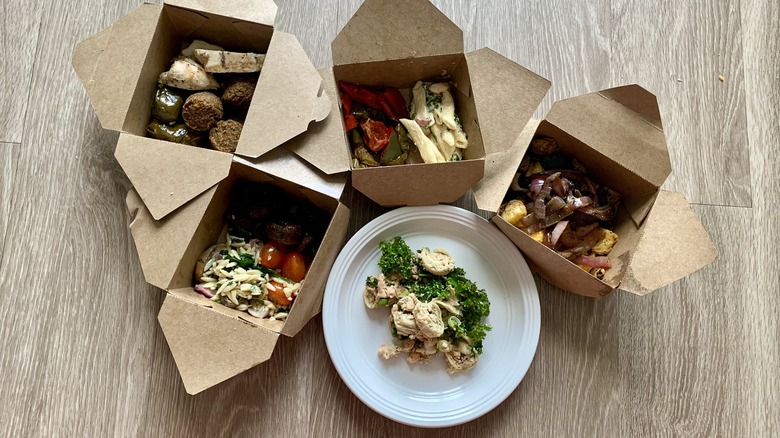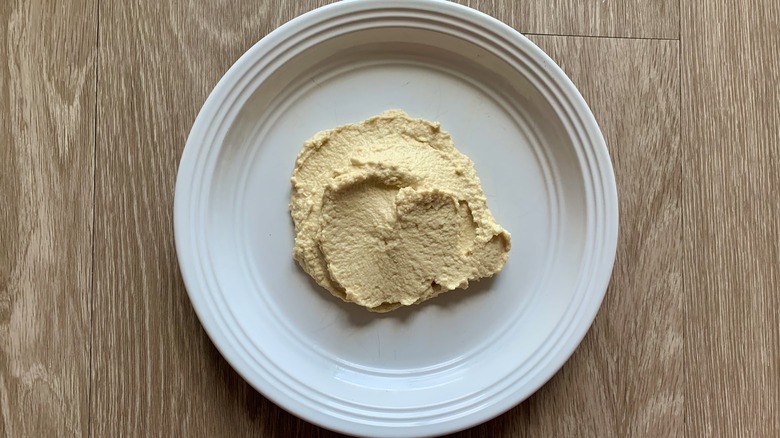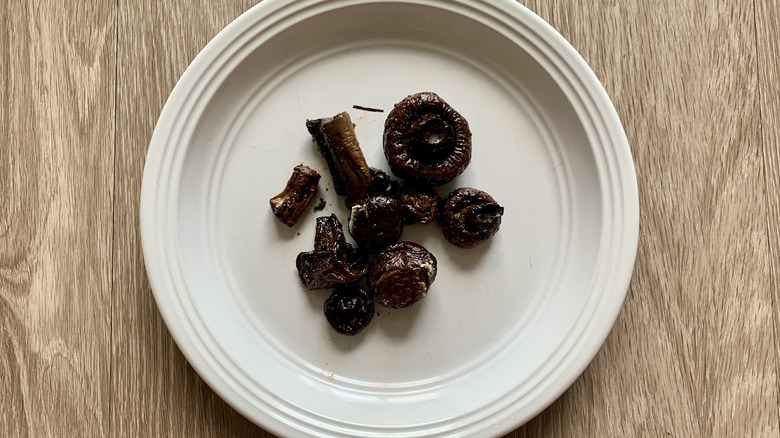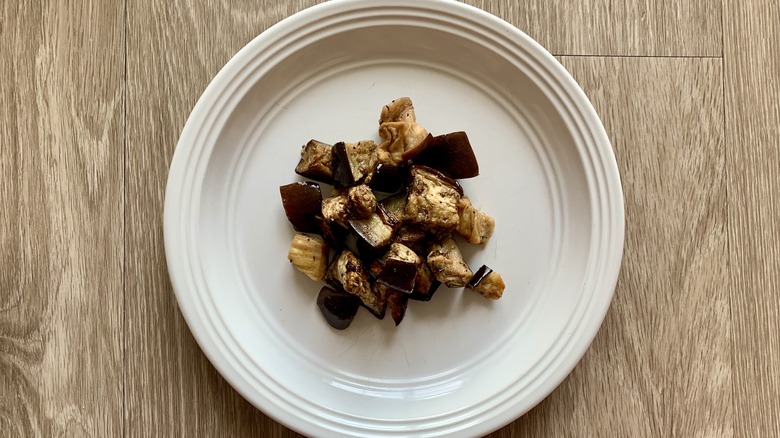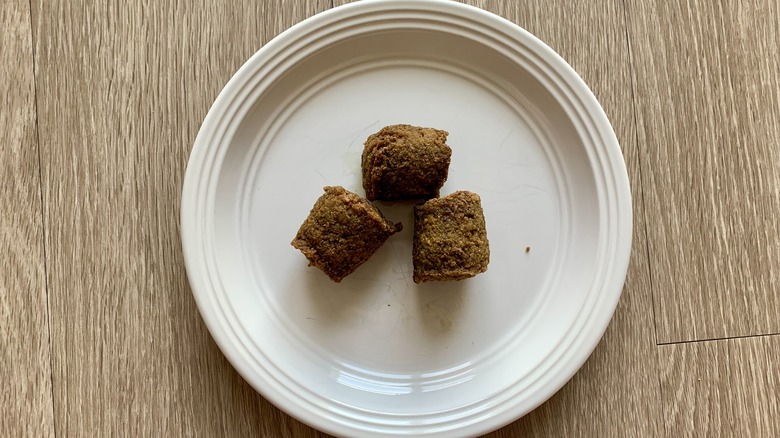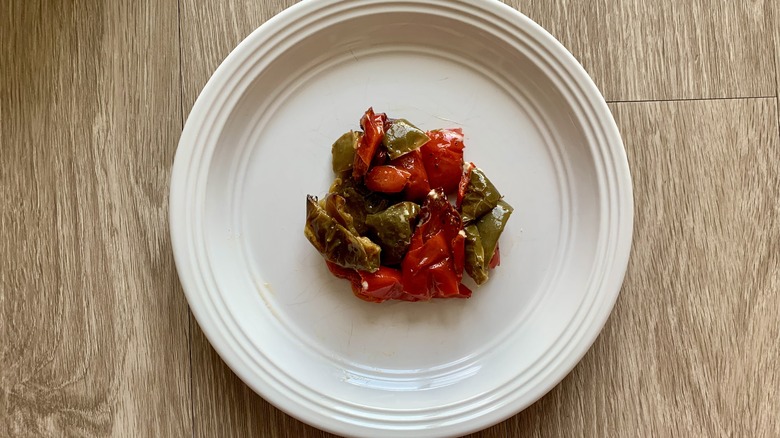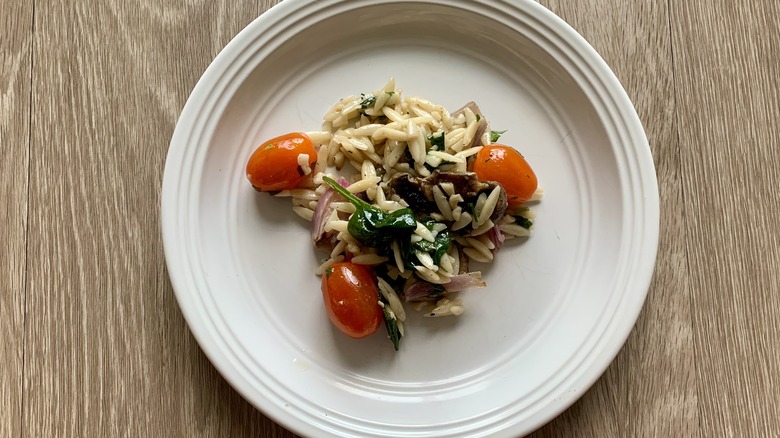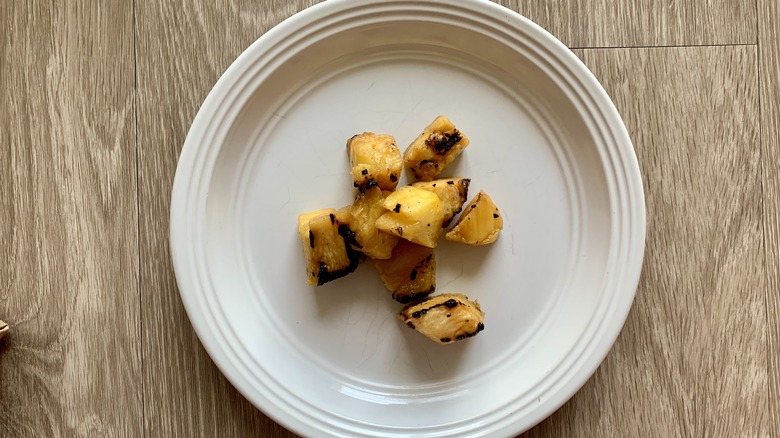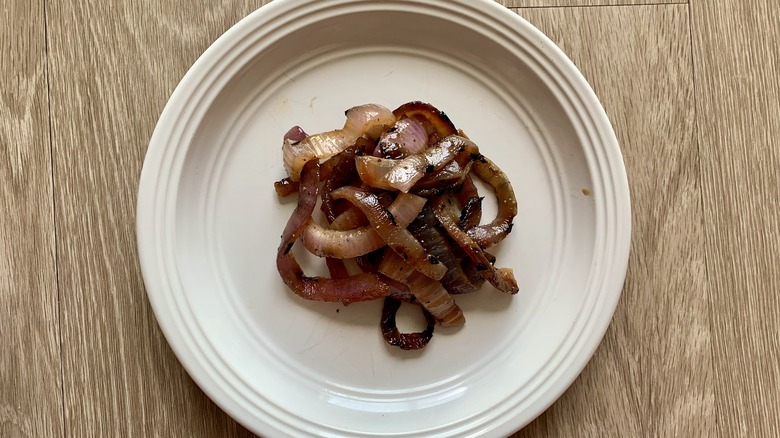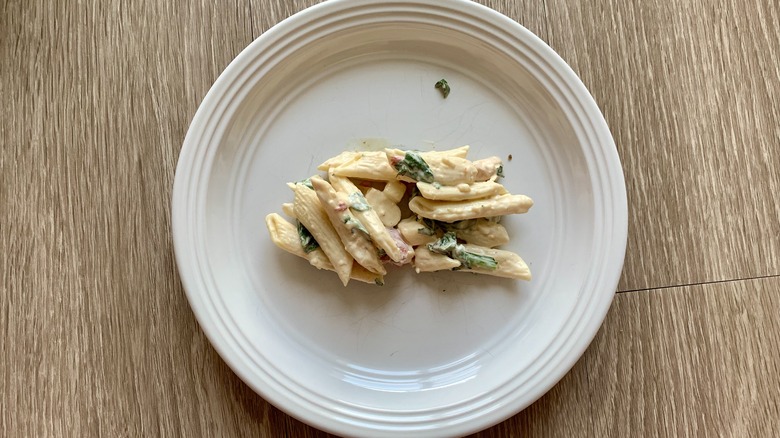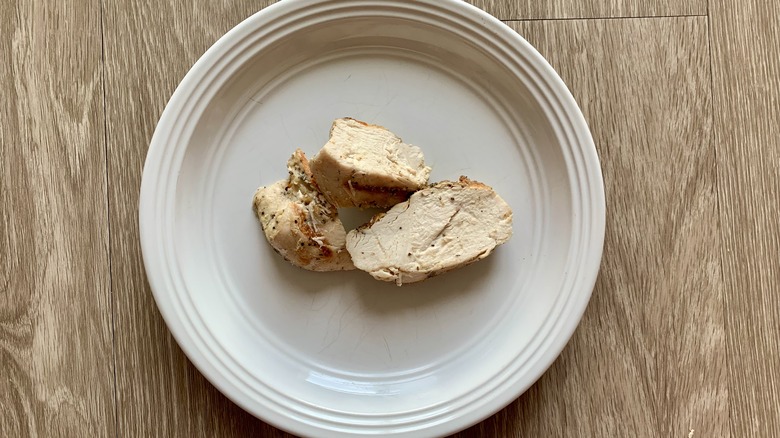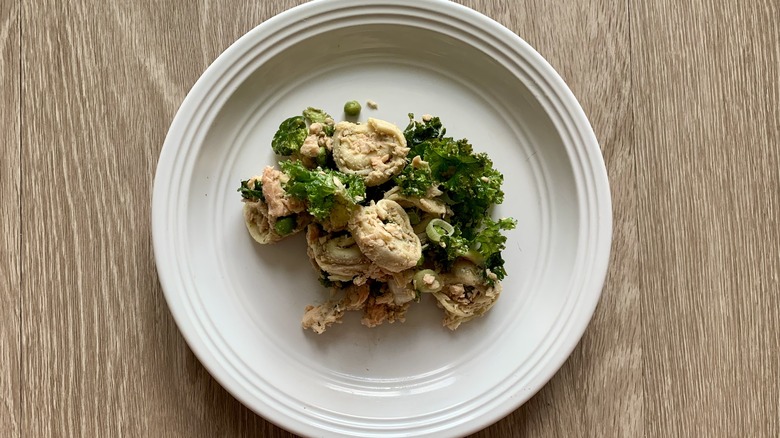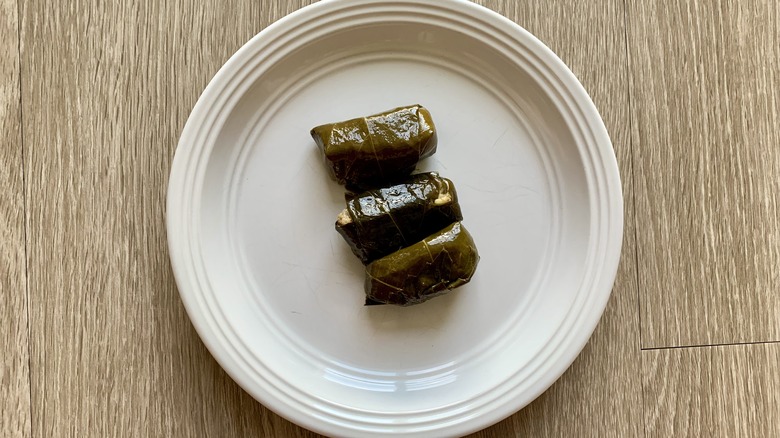12 Popular Items From The Whole Foods Salad Bar, Ranked
Shopping at Whole Foods is quite the experience. We all know that a trip to Trader Joe's is different from a trek to Aldi or Walmart, for example. But one thing that really differentiates Whole Foods is their ready-to-eat options just waiting for you at the salad bar. Tins and trays of greens, vegetables, fruits, and more, plus canisters of dressings and shakers of croutons, tempt you to throw all your previously laborious dinner plans out the window and "just grab a salad" instead. It's so easy, and if you're shopping while even just a little bit hungry or tired, it's even more tempting. So put back that package of raw chicken or box of pasta, because you don't need to turn on your oven or boil water today!
But hey, as you approach the salad bar, you are going to see a lot of options — way too many to put on even the biggest salad of your salad-eating career. You need to be a little bit particular in order to craft a salad that won't break the bank and also provide you with a sampling of all the good stuff. We've got your back on this mission because we did a test run for you. We grabbed a wide variety of salad bar items, brought them back, tasted them, and ranked them so we could guide you to Whole Foods salad success.
12. Classic Hummus
As we filled up our take-out boxes with vegetables at Whole Foods, we saw the giant mound of hummus as our pot at the end of the rainbow. Pepper and onions, even pasta salad and grilled chicken are all well and good, but we needed something lush and creamy, and hummus is one of our favorite means to that end. You may someday catch us eating hummus with a spoon and without regrets. Since Whole Foods prides itself on top-notch ingredient quality, we felt sure that their go-to hummus would be our new go-to hummus. Alas, it is not. We'll stick with our homemade simple creamy hummus whenever possible. It is super flavorful with a luxe mouthfeel that will blow your old favorite store-bought hummus out of the water.
Unfortunately, this hummus manages to be both bland and too salty, with a disappointingly grainy texture. It tastes like overly salted, blended chickpeas and not much else. We were looking for that thick, sesame-forward dip that instantly dresses up any meal, and we didn't get it. There's a chance it's a bad batch, and there's a higher chance that we'll take even sub-par hummus over no hummus when desperate, but it wasn't our favorite item we tried.
11. Roasted Cremini Mushrooms
Oddly enough, mushrooms are the sort of food that we never crave. In fact, we rarely even want them until we are presented with some, right in front of us, as an immediate side-dish option. Maybe we were out of all other vegetable-adjacent things and needed something to feel good about, or there was a big sale at the grocery store. These are fine mushrooms, for sure. They taste like a basic roasted mushroom should, meaty and ... yeah, rather like a fungus. That's not a critique, that's just how mushrooms are! Anyway, none of us regularly put mushrooms on our salad. Do you? Does anyone? If you do, these Roasted Cremini Mushrooms are a step above anything from a can or the local college cafeteria salad bar, but we would probably pass them by nine out of 10 times.
They do, at least, have that earthy flavor, but not much else. We also were disappointed in the one-note chewy texture. If we're eating mushrooms, we would rather have them stuffed to the gills with sun-dried tomatoes, or incorporated into a savory homemade pasta dish. A dinner pasta, not a pasta salad — say, mixed mushroom scampi. This is getting confusing. Anyway, they aren't the best things at the Whole Foods salad bar, but we're not mad when there were so many other more delicious items left to make up for it.
10. Roasted Eggplant
Listen, we love eggplant. We think it's one of the most underrated vegetables of all time. All sorts of other fresh produce get their moment in the sun when they are in season: strawberries, zucchini, peaches, tomatoes, pumpkins, citrus, etc. But where's the love for eggplant? Well, fine, we sort of get it. The texture is kind of squishy and weird. It's poisonous if done wrong. It's bulbous and hard to cook optimally. And the inside has a strange sea-creature appearance. But otherwise, it's awesome! In all seriousness, an eggplant dish can steal the show more than other vegetables. Eggplant Parmesan, caponata, and curry are all luxuriously delicious, making the most of that funky texture and spinning it into silken, hearty, and tender dishes with an astounding, smoldering flavor.
But Whole Foods does the eggplant a little bit dirty here, dulling its natural beauty by serving it cold and roasted in too-small bits and pieces. Some of that tenderness and flavor is still there, but it would be much better if it were better seasoned and warm. The resulting bites are somewhat leathery, a far cry from the decadence of roasted, salted, and fried eggplant of Parmesan lore. But it is a nice foil to the grilled onions and bell peppers if you want to make your salad really deep in those Italian summer-tasting notes.
9. Vegan Falafel
We were surprised by the Mediterranean fare at the salad bar on both ends of the spectrum. (See the aforementioned overly salty hummus.) The Vegan Falafel fell in the middle when we were expecting a drastically hit-or-miss item. We agreed that it succeeded on some accounts but not on others, which resulted in its middle-grade placement on our ranking. Let's get into it. Falafel are nuggets or patties of spiced chickpeas that are heavily flavored with herbs and spices and then, typically, fried in oil to give them a crisp shell and tender interior. When done right, falafel is one of our all-time favorite foods, but it's hard to find truly gold-medal-winning falafel amidst a sea of dry, flavorless letdowns.
Whole Foods really delivered on the flavor, actually. We were blown away by how aromatic, spiced, and zesty each and every bite was, down to tasting the parsley and cilantro. But on the negative side, they were quite dry and dense. We really needed a dipping sauce of some sort to make it work, and naturally, the fact that they are cold instead of piping hot from the fryer makes a big difference. These would hit the spot on a salad if we're craving the flavors of falafel, but if we really want the full glory and experience of good Mediterranean food, it's a pass.
8. Roasted Bell Peppers
Peppers are another divisive ingredient. Some adore them, others hate them; some love them raw or can only eat them roasted, and for some, it really depends on what color of peppers you are working with. Potentially the most united we can all be is in the opinion that roasted red peppers are delicious. All the wateriness of a raw pepper is eradicated under the scalding heat, leaving only the rich, robust, flavor. Unfortunately for some, there are also roasted green peppers in Whole Foods' melange. Honestly, we didn't mind, and could barely tell the difference between the two colors.
We also agreed that peppers taste better than most vegetables when roasted and then eaten cold. These will taste great on a wide variety of salad creations, from Mediterranean ones full of hummus and falafel, to Southwest-style bowls that use cheddar cheese and ranch dressings. If you're interested in roasting your own peppers and adding them to your at-home meals, review our best tips for picking the perfect pepper, and check out some of our favorite recipes that make the most of the warm flavor notes, like a classic smoky romesco sauce. In the meantime, these roasted peppers are a colorful choice that still matches just about anything.
7. Lemon Pesto Orzo
While the salad bar at Whole Foods is already ridiculously convenient. But how about a pre-made salad from the salad bar? It's basically hacking the system, people. It's worth noting, however, that this Lemon Pesto Orzo isn't really a "salad" salad, because orzo is actually a tiny, slippery little pasta. It's a great glue for sticking together some colorful add-ins with a bright dressing. In this case, we have juicy whole grape tomatoes, fresh herbs like parsley and basil, mushrooms, and more. It's convenient to eat, too, because you could practically spoon it into your mouth like oatmeal.
The dressing is nice, but more fresh-tasting than any particular lemon or pesto flavor; our other critique is that the mushrooms were somewhat unseasoned and clammy. We prefer our own recipe for an even fresher-tasting Mediterranean orzo salad. It does require more work than at the Whole Foods Salad Bar, though. Overall, we would get this again. It would be a crowd-pleasing addition to a packed picnic on a nice day.
6. Grilled Pineapple
This next item was an unexpected find at the salad bar, but now something we want on all our salads: Grilled Pineapple. Okay, not on all of our salads. It wouldn't go very well with a classic Caprese or Caesar, probably, but on more adventurous ones like a spicy taco salad? Absolutely. Raw fruit on salads is very hit or miss, perhaps because it takes away from the other ingredients, makes the greens too watery, or tastes too sweet amidst a savory meal. But grilling the fruit makes you do a double-take because even though it emphasizes the sweetness, it is then caramelized and charred, which turns it smoky and savory. Basically, there is far more flavor than you could expect from a chunk of pineapple.
Seriously, try grilling your own pineapple sometime. You'll find yourself using the fruit as a side dish to all sorts of other grilled meats and vegetables. It's magical. Except ... it's cold, as is everything else at the salad bar. Salads aren't typically supposed to be hot, but grilled foods typically are. The magic is doused, sadly, and the fruit is now limp and somewhat soggy. There's no way to re-grill grilled pineapple at Whole Foods or the run-of-the-mill workplace kitchen. Still, a little of that charred flavor remains even without the heat, so there's some good stuff left.
5. Grilled Red Onions
There are many different types of onions, from sweet shallots to sharp red onions. We love them all in different contexts and cooking methods, and do our best to treat them all as best we can by schooling ourselves on their particularities. If you're grilling your alliums, you need to choose a strong flavor that will hold its own against the high heat exposure. Whole Foods adeptly picks red onions, one of our favorites, and only adds three other ingredients: Can you guess what they are? Yes, it's simply olive oil, salt, and pepper. Though it seems like there's very little going on here, your salad can become substantially improved if you ladle a few of these on top of it next time you're at the salad bar.
For one thing, raw red onions provide a hard-hitting punch of flavor, but that flavor is divisive. Grilling quiets the acidity and that aggressive flavor (you know, that one that gives you bad breath until you next brush your teeth) while simultaneously coaxing out the more complex and nuanced flavors that get lost. Also, a little olive oil on your greens is almost always a good thing, especially when it's scented with smokiness from the grill. But, we can see why the texture of cold, slightly stringy grilled vegetables can be off-putting, so we're not judging anyone who passes due to the odd mouthfeel.
4. Smoked Mozzarella Pasta Salad
Mozzarella cheese can be really, really good when painstakingly fresh, almost dripping with its creaminess, in lush, thick slices. Maybe a tad of salt to bring out the flavor, maybe accompanied by some tomato and basil, but you have to give it the space to let its mild but mesmerizing flavor come out to play. Otherwise, nearly all the flavor is lost when pushed up against, say, sharp cheddars or hearty meats, and instead it gets reduced to being useful merely for its perfectly melty texture. In a pasta salad, it generally gets outnumbered by other ingredients and loses its luster.
In the self-explanatory Smoked Mozzarella Pasta Salad, Whole Foods hacked the system by inserting smoked mozzarella where regular would usually sit, and it's a game changer. Not only could we better taste the cheese itself, but the subtle, smokey undertones lent the whole salad a wonderfully deep, complex flavor. We think this one is definitely a few steps ahead of the regular option, and many steps ahead of any sad, soppy options you may find at the typical potluck. We were pretty impressed (and are considering adding a ball of smoked mozzarella to our shopping carts next time we're in the cheese section).
3. Paleo Chicken Breast
We mostly enjoyed this Paleo Chicken Breast with its commitment to achieving a singular directive. Instead of jazzing things up with snazzy spice blends, a golden fried breading, or accompanying sauce, this chicken is as downright chicken-y as it could possibly be. The pale, bland appearance and equally short ingredient list to any vegetable (chicken, salt, pepper, and olive oil) made us believe it would be equally bland in taste, but we underestimated it. Some salad-topper grilled chicken can taste rubbery, more like a plastic toy for a kid's cooking set than actual poultry. Whole Foods did better.
Though extremely nutritious and eschewing any additives that might turn people away, it still tastes fantastic. We would happily choose it over greasier or more aggressively flavored chicken any day. Besides, when filling your salad with colorful toppings and dressings, it's totally fine if our meat just tastes like meat. It inspired us to meal-prep by grilling up some chicken over the weekend and tossing it on salads over the work week. If you want to follow suit, be sure to follow our tips for making the absolute best grilled chicken.
2. Salmon and Dill Tortellini Salad
Tuna salad is a standard lunchtime staple for good reason. It's high in protein, ready to eat straight out of the can, and goes great in all kinds of salads. But tuna salad is a tad boring and more than a tad polarizing. Whole Foods levels up the experience by swapping in salmon, and zhushing it up with lots of cheesy tortellini, puffs of kale, and pebbles of peas — and, of course, dill, the quintessential herb for our favorite pink fish. We weren't at all excited to eat this, to be honest. We did not think we needed it in our lives. But hey, we actually sort of loved it. It's great to be humbled sometimes.
It's hearty, the salmon tastes high-quality (like it was carved off a beautifully baked fish five minutes ago), and the tortellini is a big plus. The overall texture is velvety and rich, with waifs of kale keeping everything cool. And yes, along with the orzo in the Lemon Pesto Orzo Salad and the penne in the Smoked Mozzarella Pasta Salad, we have now included a third variety of pasta in the Whole Foods Salad Bar anthology. It doesn't stop there, of course — there are countless different types of pasta out there to learn about, all of which have different applications.
1. Dolmas
If you like Greek food (which, considering the numerous options at the Whole Foods salad bar, we hope you do), you may have tried and loved dolmas. These self-contained treats are made of ribboned and rolled grape leaves, stuffed with an herbed rice mixture, and marinated in olive oil. Though they might sound a little strange to non-believers, they are basically the food of the (Greek) gods. But we've had some bad dolmas in our day, enough to pretty much determine that they aren't our thing. It's just too easy for them to be slimy on the outside and mealy on the inside. Though we half-heartedly purchased them for this ranking, we wholeheartedly ate them up. Of everything we bought, the dolmas were the dark horse favorite.
All the elements were there: The outside was soft yet firm enough to hold in the fillings, the rice was perfectly cooked and fluffy, and the flavors were subtle, light, and breezy without being underwhelming. It seems too good to be true, but yes, you can find divine stuffed grape leaves right at the Whole Foods salad bar. What they are doing there, we barely know, because according to us, they are perfectly acceptable as a whole meal, popped one by one into our mouths and enjoyed with some tzatziki on a balcony overlooking the sea. We can dream about it, at least.
